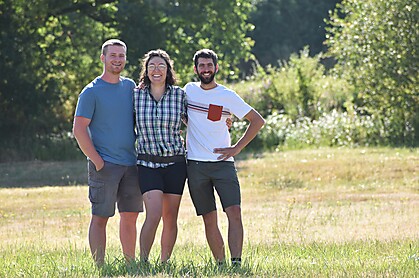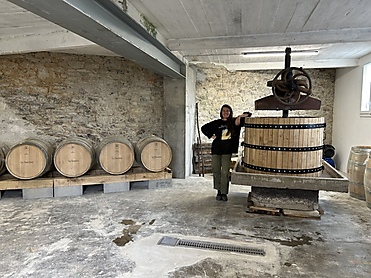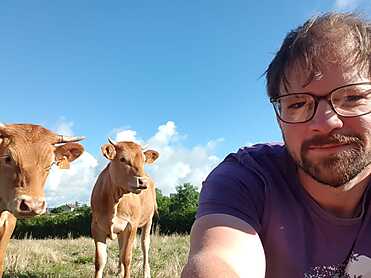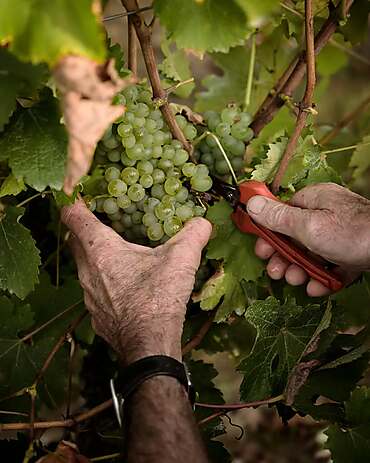Houblonnière bio expérimentale en Saône et Loire !
par
Lucile DELORME

Don avec contrepartie
Houblonnière bio expérimentale en technique culturale ancienne, douce pour la planète et à la recherche de l'avenir de la bonne bière !
Bourgogne-Franche-Comté
Verosvres, France
59
Contributeurs
4 100 €
Projet financé !
Le 15 mai 2019
English version
[FYI: THE ENGLISH REWARDS TEXT IS AT THE BOTTOM OF THIS PAGE]
**************************************
OVER 3,500€: BUILDING COMMUNAL WATER RESILIENCE FOR THE FARM
Wow! I'm really overwhelmed by how generous everyone has been in supporting me in this project! Thank you all so much!
Now that you got us to the original goal of 2,000€ to fund the structure of the hopyard, and gave an extra 1,500€ so that I can build a small hop dryer, we are going to invest in the common infrastructure here at the Ferme des Grands Noyers. There is a brand-new retaining pond that needs to be finished and pumps and natural greywater purification systems that need to be put into place. These water management tools are going to be critical to the success of my project and that of the rest of the farm as the climate changes. That's why we'll be pitching all of the funds we raise above 3,500€ into developping the farm's water and irrigation systems. (I'll still send you rewards if you decide to give, of course!)
***************************************
Hello my friends,
If you've landed on this page, you probably already know me. If not, it's a pleasure to meet you: my name is Lucile and I'm an aspiring hop farmer from central France. This campaign is to help me build an test hop yard as a vital first step toward a fully-fledged hop farm
down the road.

Spending 6 years in Portland, Oregon (aka Beervana) gave me a close and friendly relationship with beer and the hops that go into it. When my husband and I chose to move back to France, I decided to change professions and bring some of that pacific northwest culture back with me by becoming a hop farmer. I have interned at hop farms in the US and in France, attended conferences and week-long workshops on hop farming, and gone through a 9 month full-time program to get a diploma in agriculture (BPREA). After years of preparation I've decided to take a more scientific approach and start with an experiment. About a year ago I met Eric Privat on his organic dairy and egg farm in the south of the
beautiful Burgundy region. He proposed that I do a year of apprenticeship on his farm so I could set up a yard test and help figure out what the future of organic hop production in this area might look like.
Why do I think this test hop yard is so important?

Terroire & Locality
Hops are a lot like wine grapes: they are long-lived plants, taking 3 years to achieve maturity for a first good harvest. And like wine, hops take on the unique character of the place where they are grown, climate and soil composition. A Cascade grown in France isn't the same as one grown in the Cascades. The only way to know what a variety will taste like when grown in a particular place is to grow it in that place. Hops used to be grown all throughout western Europe, but with the rise of monocultures and industrial farming the number of hectares in France was down from 4000 to 400 in 80 years and all of it concentrated in two regions in the Northern part of France. We are just starting to rediscover the regional flavors of the beers of our great-great-great-great-grandparents, and I think that each region deserves to have its own unique taste. This yard is a part of that process of rediscovery.

Climate change
I'm not going to lie ; starting up as a hop farmer just as the effects of climate change are really starting to be felt scares me. Hops are a tough plant and can adapt to survive in a wide range of climates, but the style of industrial farming that today produces the best quality cones for brewing is very water intensive and not particularly excellent for the soil. I believe that it's possible to farm this amazing plant in a way that consumes less water, that recaptures carbon in the soil, and that is more resilient to a changing climate. And I believe that we have to develop these new ways of farming if we are going to enjoy beer well into the 21st century.
Biodiversity
This project isn't just about hops: this yard is going to be home many species of plants (and some animals!). Modern industrial farming focuses on producing as much of one product as humanly possible, removing all other life from the soil (above and below ground) and killing any insects on the plants. This contributes to soil depletion, the loss of insect biodiversity, and the declining bird populations we see all across the developed world. But it doesn't have to be that way. Pioneers in permaculture and other eco-friendly farming techniques have shown us that it's possible to grow a variety of crops in the same field such that they are not in competition but in cooperation with one another and the natural fauna of the area. By building bird boxes at the tops of my poles, fostering a thriving insect population in the yard, and allowing chickens in the run of the yard at the right moments during the growth cycles of the plants, I believe that it's possible to create a hop yard that is both productive and a boon to local biodiversity.
Ok, so what would that look like in practice ?

This test yard will be a somewhat oblong piece of land, 80 meters long by 36 meters wide.I'm testing a modern adaptation of an old hop farming technique from England. Instead of planting the hops in long rows of very tall poles (up to 9 meters) with the plants placed as close as possible to one another, I'm choosing to plant my hops in a square formation.
The usual rows arrangement takes just one or two of the bines that the hop rhizome puts out and trains them on a long cord up to a metal cable that's strung across the tops of the poles. So each plant is really only producing a couple of very long bines.

In the square formation, 8 to 12 of the bines are selected to grow off diagonally in opposite directions. With more space between the plants and a lower trellis structure (about 6 meters), I believe that one plant can produce just as much or more than in the super-tall rows arrangement. In its peak growth time, a hop plant puts out around 25 shoots that, in a conventional structure, have to be cut down continually adding a lot of soil work and opportunities for diseases to enter the plant. Since the plants are farther from each other, that extra space lets more air flow in, helping reduce the pressure of diseases like downy mildew, or spider mite attacks compared to conventional farming.
I think that hop plants grow can vigorously while surrounded by other species, knowing that in nature they live in symbiosis with trees and other plants on wooded river banks or in hedgerows. So I have decided to grow a variety of berries between the rows to add biodiversity in the hop yard and create a diversified production that could be complimentary on a larger scale farm. I will be trying to see if this is a mix that works well
together, on both an ecological and economical level. Any space that's not covered by another plant will have nitrogen fixing clover and native grasses, and the few patches of truly bare soil I'll need to maintain will get a covering.The chickens will naturally fertilize my soil as they freely roam around, chasing little bugs and larvae. All of this to fix as much carbon into the soil as possible, increasing fertility and developing a way of farming hops that helps combat climate change.

I have decided to design my hop yard in order to adapt to already functioning natural systems instead of destroying the soil balance. The trees that were in the field when I arrived (now trimmed with the “trogne” technique) along with my added crops will continue to “drink” excess water and host beneficial insects. I will maintain a natural pocket in thecenter of my crops, hosting millions of insects that all have a role in the balance that I am trying to achieve

Where is this experiment taking place ?
On the Ferme des grands noyers (« Farm of the big walnut trees ») in the Saône-et-Loire department, Burgundy region of France. This organic dairy and egg farm has been a welcoming place for young farmers and a place to build community for decades. The farmer Eric, along with his kids and his partner Helene, produces not just milk and eggs for local distribution but also cheeses, yogurts and desserts that they transform and sell on the farm and through local nonprofits. Eric, has generously opened up his farm to us and is letting me install this test yard on a
good piece of land near the spacious chicken run that his hens spend their daylight hours pecking about it. Helene even let me help her build the apartment that my husband and I live in now out of natural, local and ecologically friendly materials. Eric and Helene both hope to turn this farm into a thriving hub of community, with multiple families living together producing a diversity of products and hosting community events throughout the year. He has been absolutely indispensable in the planning and building process of the hop yard itself, and I cannot express just how grateful I am for his help!

We are deeply grateful to both of them and to everyone who has been a part of making La Ferme des Grands Noyers what it is.

This all sounds great, but it can't be that simple… I'm not going to lie to you : this is an experiment. Hops haven't been grown in this area for brewing for decades and a lot has changed about the soil and the climate since the last time they were. It's possible that the hops won't take. It's possible that some parts of my ideal plan will have to be changed or scaled down. But that's why I'm doing this : to test, to
learn and to share the results. I plan to document the process and the results of this experiment in as much detail as possible to freely share what I find with anyone who wants to know. Hoping that the way we farm hops in the future can be a part of growing the world we want to live in. This would be just one tiny part of that transformation, but I hope it would be a meaningful one. My mission is to farm this fascinating plant, and to do so in a way that contributes to the needed transformation of our agricultural practices, and the only way that's going to
happen is if people like me develop the techniques and the know-how to make it happen. I'm hoping that you'll think it';s important, or at least interesting, enough to help out on this first step.

A quoi va servir la collecte ?

This is a small test yard, but even so the amount that we're trying to raise won't cover the whole cost of the yard. My husband and I have been saving for this project for several years now, and we're putting in the money for things like the hop plants, the chestnut poles, the small fruits, and the heavy equipment rental for installing the poles. What I need from you is to give some structure to this whole thing: the cables and anchors that make the whole yard stable and able to support the weight of the hops and all the other small metal pieces to put the whole thing together.
Here’s how I’ll use the money I raise in this campaign :
All those cables, tools, fasteners, and other metal bits: 1 340€
Thank-you gifts for the campaign : 500€
The 8% platform fees from MiiMOSA : 160€

Here's how that budget breaks down :
Hop plants: 440€
Small fruit plants: 400€
Chestnut poles: 400€
Hefty Steel Cables: 1 150€
Anchors: 580€
Heavy machinery rental: 600€
Fasteners and tools: 500€
Coconut fibre cords: 100€
Ground coverings: 130€
= 4 300€ (about $4,850)
My husband and I have already invested more than 3 000€ to begin the set-up of the yard, and what we’re asking for is help getting us over the finish line. We would so very much appreciate your help! The drip-irrigation system can be put in place thanks to Eric, a pond just next to the yard, and the equipments he already has on the farm.
For 10 € or more
A big thank-you!
Thank you so much for supporting my grand experiment!
I will mail you a hand printed post-card (by a local artist and myself) to keep you up to date on how things are going and share the first results of the hopyard with you once I know more.
Disponibilité : August 2019
Livraison : International
for 25 € or more
Raise a glass to you!
I'll pour you a beer* at a harvest festival in early September on the farm, and you'll keep the cup (an ecocup printed with the she-wolf logo). If you're far away and can't make it, we'll raise a toast in your honor and send you the video.
Disponibilité : September 2019
Livraison : A retirer sur place (Les Grands Noyers, Verosvres, France)
For 50 € or more
The howl of the she-wolf: hand-screenprinted bandana I'll hand screenprint an all-coton bandanna with the she-wolf logo on it just for you and send it to you, wherever in the world you might be along with lots of love and gratitude. If you're able to come to the farm, I'll also give you one of those fancy printed cups (with beer in it, naturally).
Disponibilité : September 2019
Livraison : International
For 100 € or more
Your name carved into a hop pole
Along with everything else mentioned so far, I'll carve your name into one of the 28th poles that support the hop yard. You know how cheesy teens in movies carve the names of people they love into telephone poles? Yeah, like that. If you're far away I'll send you a postcard with a
picture of it.
Disponibilité : Août 2019
Livraison :
For 250 € or more
Custom-made jewelry!
I'm a jeweler by training, and I haven't yet lost my touch. I'm going to make a limited series of special sterling silver + black walnut jewelry themed around hops and beer. You'll be able to pick one for yourself. There will be masculine as well as feminine oriented pieces. Earrings, bracelets, cufflinks, necklaces... I’ll send you drawings and you can pick your favorite! (if you're in the US I'll find a way to get it to you before the Holidays)
Disponibilité : December 2019
Livraison : International
Contreparties
Pour 10 euros ou plus
Un grand merci!
Merci infiniment pour le soutient que tu m'apportes! Une jolie carte, imprimée à la main en lithographie par une artiste locale et moi-même, arrivera dans ta boîte aux lettres t'apportant des nouvelles de mon expérimentation et les premiers résultats que l'on va pouvoir répertorier grâce à toi!
Disponibilité
août 2019
Choisie 2 fois
Pour 25 euros ou plus
Je lève mon verre à..!
Pour la journée portes-ouvertes et l'inauguration de la première récolte, je te servirai une bonne bière fraiche dans un verre que tu emportera avec toi en souvenir de ce jour! Si tu ne peux pas être présent ce jour là, on filmera le toast que je te porte et on t'enverra la vidéo en attendant que tu puisses venir chercher ton verre et une bière! Tu recevra aussi la carte de remerciement qui t'informera des premiers résultats si attendus de ce champ expérimental!
Disponibilité
septembre 2019
Livraison
À retirer sur place
Choisie 14 fois
Pour 50 euros ou plus
Un bandana de la Louve!
Je vais faire imprimer à la main une série de bandanas en coton au logo de la Louve houblonnée. En plus de la carte de remerciement et du verre à bière (rempli), tu pourra te la jouer cow-boy/girl avec ce bandana et faire vivre l'esprit Américain qui a vu naître ce projet! Disponible en un coloris.
Disponibilité
septembre 2019
Livraison
Nationale
Choisie 9 fois
Pour 100 euros ou plus
Ton nom gravé dans le chataîgner!
En plus des contreparties précédentes, j'ai décidé de graver ton nom au pyrograveur sur les poteaux à l'entrée de ma houblonnière, pour me rappeler tous les jours que dans cette aventure je ne suis pas seule et que toi aussi tu crois en l'avenir de la bonne bière Française et du bio! Promis, je ne graverai pas nos initiales entourées d'un cœur... enfin, peut-être pas..
Disponibilité
août 2019
Livraison
Nationale
Choisie 6 fois
Pour 250 euros ou plus
Un bijou en argent, fabriqué par mes p'tites mains!
Je suis bijoutière de métier et il y a des choses qui ne s'oublient pas! En plus de toutes les contreparties précédentes, je concocte une petite série de bijoux inspirés du houblon et de la bière! Entièrement fabriqués à la main par mes soins, ils seront en argent 925 millièmes et en bois de noyer. Il y en aura pour tous les styles! Boucles d'oreilles, bracelets, bagues, boutons de manchettes... Je t'enverrai une série de croquis et tu choisira ton bijou préféré!
Disponibilité
décembre 2019
Livraison
À retirer sur place
Choisie 6 fois
Don libre
1
Sélectionnez un projet
en fonction de la thématique, de sa localisation ou des contreparties.
2
Choisissez une contrepartie
et ajustez si vous le souhaitez le montant de votre contribution.
3
Recevez vos produits
ou profitez des séjours et expériences que vous avez choisis.
4
Partagez votre expérience
sur les réseaux sociaux @miimosa_fr pour continuer de soutenir le projet et son porteur.





